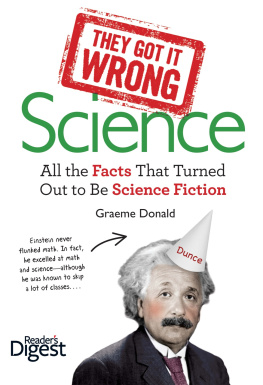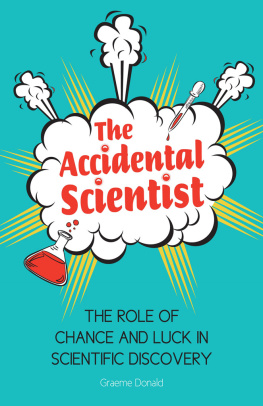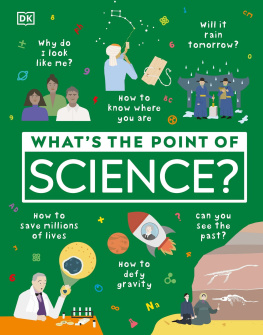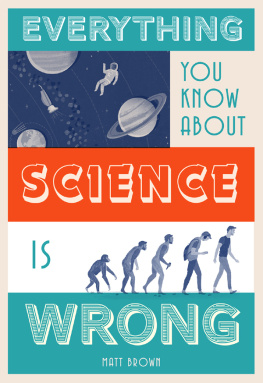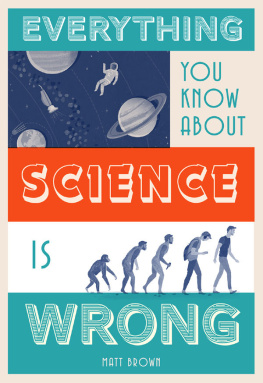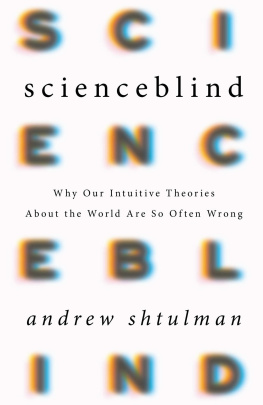
A READERS DIGEST BOOK
Copyright Michael OMara Books Limited 2013
All rights reserved. Unauthorized reproduction, in any manner, is prohibited.
Readers Digest is a registered trademark of The Readers Digest Association, Inc.
First published in Great Britain in 2011 by Michael OMara Books Limited, 9 Lion Yard, Tremadoc Road, London SW4 7NQ
are hereby made part of this copyright page.
Library of Congress Cataloging-in-Publication Data
Donald, Graeme.
Science : all the facts that turned out to be science fiction / Graeme Donald.
pages cm -- (They got it wrong)
Summary: The fascinating stories behind 50 scientific theories that were once regarded as facts but history proved were pure fictions.This is an innovative way into some truly zany bits of science and history that will surely fascinate readers. They Got It Wrong: Science tells the story behind 50 scientific theories that were once widely believed to be true, but history has since proved to be wrong, and the consequences it brought on at the time. Contents include: When the Earth was Flat, Tobacco can cure a variety of Health Problems, All Base metals can be turned into gold, how the physical measurements of the skull correlate to a persons personality, and more-- Provided by publisher.
Includes bibliographical references and index.
ISBN 978-1-62145-009-2 (hardback) -- ISBN 978-1-62145-023-8 (adobe) 1. Errors, Scientific--Miscellanea. 2. Pseudoscience--Miscellanea. 3. Science--History--Miscellanea. I. Title. Q172.5.E77D66 2013
500--dc23
2012039974
ISBN 978-1-62145-009-2 (hardcover)
ISBN 978-1-62145-088-7 (paperback)
We are committed to both the quality of our products and the service we provide to our customers. We value your comments, so please feel free to contact us.
The Readers Digest Association, Inc.
Adult Trade Publishing
44 South Broadway
White Plains, NY 10601
For more Readers Digest products and information, visit our website:
www.rd.com (in the United States)
www.readersdigest.ca (in Canada)
For Rhona, as ever, and with very special thanks to Kath Kay-Dee Davies, who selflessly moved heaven and earth to give me the time to bring the manuscript in on time.
INTRODUCTION

F rom ancient times to the modern day, science has strayed many times from the truth.
Often discoveries have been dictated by the constraints of contemporary thought. Take, for instance, the Ancient Greeks. They were so limited by their lack of knowledge of the human anatomy that they developed the theory that the body is made up of four humors, an idea that held sway until the march of scientific medicine in the nineteenth century (see ).
Other times false ideas were the result of pure folly, such as the seemingly innocuous development of phrenologya concept eventually used to justify genocide in Rwanda in the late twentieth century. Sometimes scientific facts have been explored in an effort to lend false support to a hidden agenda, including the appropriation of the entirely spurious notion of subliminal messaging by politicians and the Christian Right. Despite the questionable nature of these ideas, They Got It Wrong: Science will highlight how man has beenand perhaps always will beat the mercy of science.
Thankfully, not all the parts of science we got wrong have had devastating impacts; some of the examples in this book will raise a smile. Whether its the alchemists search for the philosophers stone (the vehicle through which all base metals could be turned into gold), the somewhat surprising history of the vibrator, or the many proponents of the hollow earth theory, the annals of science are littered with strange people and their even stranger ideas.
What is perhaps most surprising is that some of sciences most bogus ideas have been only recently relinquished. No matter how advanced todays medical and scientific thinking might be, who is to say that in one hundred years time a book similar to this one wont be ridiculing todays wisdom?

The physical measurements of the skull correlate to a persons personality.
T he majority of the scientific frivolities of previous centuries inflicted little or no real harm during their reign and evaporated without much trace in the light of new discoveries. Unfortunately, the same cannot be said for the pseudoscience of phrenology, which caused wide-ranging injustices and misery in its time and, most damaging of all, reached out from its grave to promote genocide at the close of the twentieth century.
The Gall of It
The father of phrenology was the German physician Franz Joseph Gall (17581828), a product of the University of Vienna, an institution that served as a breeding ground for several other spurious notions about the human race (see ). Gall developed the theory that the human brain is comprised of twenty-seven distinct zones,
each of which is a wholly separate and autonomous organ with individual responsibility for certain functions, characteristics, and predispositions.
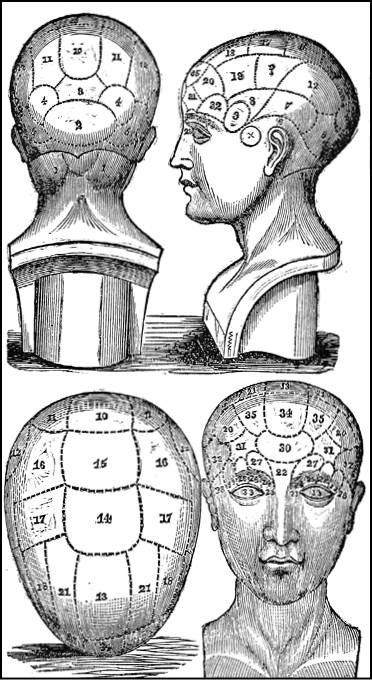
The phrenological bust
Mini Myth
Lessons in Idiocy
By 1925 the University of Vienna had become an intellectual hotbed of racist ideology. The most notorious and far-reaching of such notions was Rassenpflege the quest for racial hygiene. Professor Otto Reche, director of the universitys Department of Anthropology, was the most vocal proponent of such ideas, proclaiming, Rassenpflege must be the basis for all domestic policy and at least a part of foreign policy as well.
The more an individual used one of the zones, or allowed themselves to be driven by the emotional or physical urges dictated by it, the larger that zone would becomesimilar to an overused muscle. In Galls defense, his findings were not completely off the mark: It is now known that certain areas of the brain are linked to specific functions or temperament, and that some of these areas can become enlarged with mental exercise.
Had Franz Gall finalized his research at this point, no harm would have resulted. His error was in expanding the basic premise into the foundation stone of a sizeable edifice of speculation and assumption. By 1805 Gall had decided that the twenty-seven zones must be responsible for the lumps and bumps on the anterior of the skull, which they pressed against as they swelled with exertion.
Reality Check
Brain Training
In March 2000, Professor Eleanor Maguire of University College London published the results of an extensive study she had conducted into the pattern of growth of the hippocampi in the brains of London taxi drivers. They were chosen because they were required to take the knowledge, the formidable exam that demonstrates their ability to work out the best route between any two nominated points in the city. Professor Maguire deduced that the longer the driver had been working, the more pronounced the enlargement of the hippocampus.
Lunacy
Gall conducted exhaustive fingertip exploration on the skulls of murderers, burglars, and other categories of criminals and decided that there were sufficient significant similarities between them to establish a pattern. He also conducted similar explorations on the skulls of the insane and decided that their individual conditions were attributable to specific zonal malfunction. Again, in defense of Gall, some good did come of this thinking, as the insane were previously thought to be willfully so or possessed by the devil, and thus were beaten regularly. Such was the standing of phrenology that, almost overnight, the insane were for the first time regarded as genuinely ill and treated accordingly.

